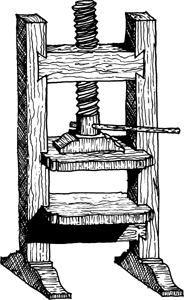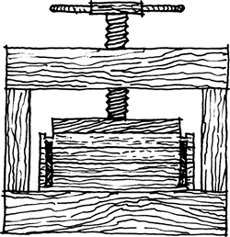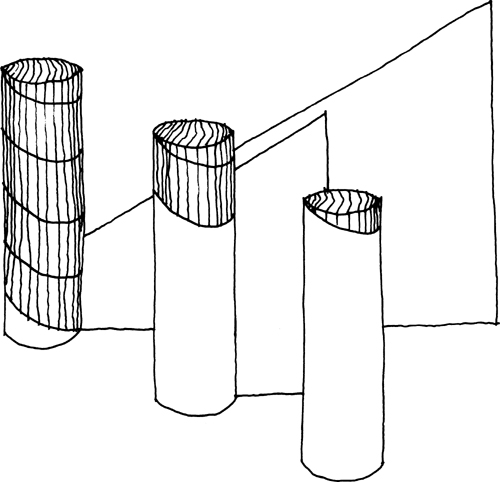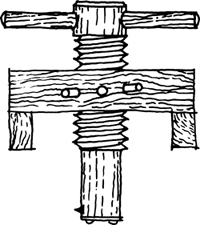Printers at work, Frankfurt-am-Main, 1568.
MAUDSLAY HAD WHAT IS Often called a mechanical bent. So did the men he trained. Whitworth was the best known, but there were others: Joseph Clement, whom Charles Babbage commissioned to build his famous difference engine, the calculating machine that anticipated the modern computer; Richard Roberts, whose metal planing machine was capable of such precision that he used it to manufacture iron billiard tables; and Maudslay’s personal assistant, James Nasmyth, who went on to invent the steam hammer and the pile driver. Like their master, these men generally came from modest backgrounds: Whitworth was the son of a schoolteacher; Clement’s father was a weaver; Roberts’s, a shoemaker. Moreover, they grew up not in cities but in small, remote villages or rural towns, without the least exposure to engineering. They often reached their calling by circuitous routes. Maudslay himself was apprenticed first to a carpenter; Roberts began as a quarryman; Clement was a slater’s assistant. Despite such unpromising beginnings, all were attracted to the world of machines.
“My first essay at making a steam-engine was when I was fifteen,” Nasmyth told his biographer. “I then made a real working steam-engine, 13/4 diameter cylinder, and 8-in. stroke, which not only could act, but really did some useful work; for I made it grind the oil colors which my father required for his painting.”1 Nasmyth’s background was different from that of his colleagues. He was born in a large city, Edinburgh, to a prosperous family—his father was the well-known Scottish landscape painter Alexander Nasmyth. James attended the High School in Edinburgh, the School of Art, and the university. In his spare time he continued his mechanical experiments with steam engines, casting parts in his bedroom, hanging around machine shops. The municipality was debating the wisdom of adopting steam-powered carriages for public roads, and Nasmyth achieved a small measure of local renown by building a vehicle that carried eight persons. This was more than two decades after George Stephenson built the first steam road-carriage, but it was still a remarkable accomplishment for a self-taught young man not yet twenty. Finally, having determined to pursue a career in mechanical engineering, Nasmyth decided to apprentice under the famed Henry Maudslay. He traveled to London and presented himself to the great man, bringing with him a working model of a steam engine. Maudslay, who no longer took pupils, spent twenty minutes examining the beautifully made engine, then took the young man on as his personal assistant.
Maudslay recognized in Nasmyth traits shared by all these men: an innate love of mechanics, a natural aptitude for working with metals, and above all a devotion to precision. Precision was an absolute standard. Maudslay, for example, produced regulating screws of much greater accuracy than was required by industry at the time; Whitworth built himself a micrometer that was accurate to one-millionth of an inch. These men are called engineers, but this designation is inadequate. For one thing, they were working in uncharted territory in which invention as well as technical proficiency was required. They were not simply designing replacements for traditional craft methods; they were inventing tools that were capable of previously unimagined accuracy. Moreover, these were also extremely skilled craftsmen. Indeed, the ability to actually make—with their own hands—what they conceived is an integral part of their achievements. “It is one thing to invent,” observed Marc Brunel, “and another thing to make the invention work.”2
An affinity for steel and iron is a gift, like perfect pitch for a musician. These engineers had the artist’s independence. Joseph Clement once received an order from America for a large regulating screw to be made “in the best possible manner.” He produced an object of unparalleled accuracy and submitted a bill for several hundred pounds to his shocked client, who had expected to pay at most twenty (the case went before arbitrators and the American lost). In another case, Isambard Kingdom Brunel, who was in charge of building the Great Western Railway, commissioned Clement to design a piercing locomotive whistle. Delighted with the prototype, Brunel ordered a hundred. He, too, was shocked at the high price and declared that it was six times what he had previously been paying. “That may be,” responded Clement, “but mine are more than six times better. You ordered a first-rate article, and you must be content to pay for it.”3 He won that case, too.
Mechanical genius is less well understood and studied than artistic genius, yet it surely is analogous. “Is not invention the poetry of science?” asked E. M. Bataille, a French pioneer of the steam engine. “All great discoveries carry with them the indelible mark of poetic thought. It is necessary to be a poet to create.”4 Nevertheless, while most of us would bridle at the suggestion that if Cézanne, say, had not lived, someone else would have created similar paintings, we readily accept the notion that the emergence of a new technology is inevitable or, at least, determined by necessity. My search for the best tool of the millennium suggests otherwise. Some tools were developed in direct response to a particularly vexing problem—this was the case with the Roman frame saw, or the socketed hammer. No doubt these devices would have appeared sooner or later. But the sudden and “mysterious” appearance of tools such as the carpenter’s brace or the medieval bench lathe cannot be explained by necessity. Such tools are the result of leaps of an individual’s creative imagination. They are the product of brilliant, inventive minds whose intuitive perceptions of complex mechanical relationships really are poetic.
—
The screwdriver is hardly poetic. The pragmatic way in which the arquebusier’s spanner and the armorer’s pincers were modified to include a screwdriver, or the casual combination of a screwdriver bit with a carpenter’s brace, suggest expediency rather than invention. The screw itself, however, is a different matter. It is hard to imagine that even an inspired gunsmith or armorer—let alone a village blacksmith—simply happened on the screw by accident. To begin with, the thread of a screw describes a particularly complicated three-dimensional shape, often misnamed a spiral. In fact, a spiral is a curve that winds around a fixed point with a continuously increasing radius. A clock spring forms a spiral; so does a rope neatly coiled on the deck of a sailing ship. A helix, on the other hand, is a three-dimensional curve that twists around a cylinder at a constant inclined angle. So-called spiral staircases and spiral bindings are both examples of helixes. So, of course, are screws.
The helix occurs in nature in the form of the climbing vine and in some seashells.I But it requires a particular set of talents to invent a screw. First, it would take a skillful mathematician to describe the geometry of the helix. Then he—or someone else—would have to make the connection between theoretical mathematics and practical mechanics in order to imagine a use for such an unusual object. Finally, there would be the problem of how to actually fabricate a screw.
The builder of the Housebook lathe, whoever he was, resolved the problem of how to make a screw, but he did not invent the screw itself. An understanding of the principle of the screw predates the fifteenth century. The first documented use of the word screw, according to the Oxford English Dictionary, is in 1404. It occurs in a list of accounts: “Item 1 rabitstoke cum 2 scrwes” (the word was also spelled skrew, skrue, and scrue). A rabitstoke, I learn, is a plane for shaping complicated grooves, or rabbets; the two wooden screws, holding an adjustable fence, are part of the tool.5 Small wooden screws were also used to make bench vises and assorted clamps; large wooden screws adjusted the vertical and horizontal angle of cannons.
The most famous use of screws in the Middle Ages was in printing presses. Johannes Gutenberg played a pivotal role in the invention of movable type in the mid-1400s; unfortunately, there is no surviving description of his press. The earliest known representation of a printing press is about fifty years later. It consists of a heavy wood frame with a crosspiece through which a large screw is threaded. The screw is turned by means of a handspike, or lever, and pushes down a wooden board, which in turn presses the paper against the inked type.
The medieval printing press was likely an adaptation of a similar press that was used in paper-making. Stacks of damp sheets of paper, alternating with layers of felt cloth, were squeezed dry between two boards. But there might have been other models, for presses had many applications in medieval times. Linen presses, which were found in every large household, gave freshly woven cloth a smooth, lustrous finish. Olive and grape presses were used for pressing olive oil and wine. Apple presses made apple juice; seed presses squeezed oil from rapeseed and flax. All these presses used a vertical screw that was turned to exert downward pressure.
The printing press and the paper press were medieval devices, but linen presses had been used since Roman times. A picture of a linen press with a heavy wooden frame and not one but two screws survives in a Pompeian fresco. The origins of olive and wine presses are ancient, too. The Roman architect Marcus Vitruvius Pollio, who lived sometime in the first century B.C., mentions olive-oil presses in The Ten Books on Architecture. In a passage on farmhouse planning, he describes a “pressing room” where olives are pressed to make oil. He writes that the room should be not less than forty feet long in order to accommodate the traditional beam press, but adds that such a large room is not required if the press is worked by “turning screws.”6

Medieval paper press.
Roman linen press, from a mural painting found in Pompeii.
The discovery of the screw press is described in detail in Historia Naturalis, published in A.D. 66 by Pliny the Elder. Pliny credits Hero of Alexandria with the invention. Hero was a mathematician (he discovered the formula for calculating the area of a triangle), but like most ancient mathematicians, he was also interested in mechanics. According to Pliny, Hero began his experiments with presses by improving the traditional beam press. The beam press consisted of a long wooden beam (prelum) whose end was inserted into a pocket in a wall. The beam was raised, and a bag of macerated olive pulp was placed beneath it, like a nut in a giant nutcracker. Then the beam was pulled down by means of a rope wound around a drum. To get rid of the clumsy rope, Hero inserted a large wooden screw, fixed to floor and ceiling, through the beam. As a nut was turned, the beam was forced down. This worked well, but Hero found that the nut had a tendency to jam. He then took a different tack. He attached a heavy stone to the bottom of the screw. Now, as the screw was turned, it lifted the stone, whose weight carried the beam down. “When you have hung up the stone and left it to itself,” Hero wrote, “the prelum will do the pressing without your having to repeat the pressure several times.”7
Pliny describes the weighted beam press as “very much praised.” Nevertheless, pulling up a weight in order to pull down a beam is hardly elegant, and Hero was not satisfied. Instead of pulling a weight up, he asked himself, what if the screw was used to push down? At the same time, what if the prelum was eliminated altogether? Thus Hero invented the direct-screw press, the ancestor of the printing press. In fact, his machine is virtually indistinguishable from later presses. “We fix on the table two uprights,” Hero writes in his detailed and lucid description, “which carry the crosspiece. . . . The screw hole should be in the middle of the crosspiece. The screw is put through this hole and turned by means of handspikes till it reaches the lid which is laid on the galeagra [the box containing the fruit] and presses it down and the juice flows.”II,8
The screw-down press is a marvelous invention, not only because it is simple and compact but also because it is capable of enormous pressure. The downward force is a direct function of the ratio between the pitch of the screw and the circumference described by the handspike. For example, imagine a press of the type described by Hero whose large screw has a pitch of one inch, and which is turned by means of a handspike three feet long. If a man applies a force of, say, forty pounds to the handspike, the pressure exerted on the olive pulp will be more than nine thousand pounds. The ability of a single man—working without animals or waterpower—to exert this kind of force was unprecedented.

Hero’s direct-screw press.
—
Hero invented a variety of machines in which he often incorporated a common mechanical device that the ancient Greeks called an “endless screw,” today referred to as a worm gear. A worm gear is a combination of a long screw and a toothed wheel; each revolution of the screw advances the wheel a minute distance. The mechanical advantage depends on the pitch of the screw and the number of teeth in the wheel. Hero incorporated several endless screws into his hodometer, or “road measurer.” The instrument was fixed atop a cart whose axle powered a train of endless screws that, at predetermined intervals, released a pebble into a box. The surveyor had only to count the pebbles to compute the distance traversed. Hero also invented the dioptra, an ancestor of the theodolite. The dioptra was mounted on a tripod or pedestal and the surveyor squinted down a sight whose horizontal and vertical orientation he adjusted by means of two worm gears, here used as regulating screws.
The screws used in ancient worm gears were usually bronze; screws for presses were wood. Both screws were made by tracing a helix onto a cylinder or rod and filing or carving the thread by hand. The template was a sheet of soft metal in the shape of a right-angled triangle. According to the ancient instructions, the triangle was wrapped around the rod so that one arm of the right angle was parallel to the axis, the hypotenuse automatically tracing a helix on the rod.9 I couldn’t quite imagine this, so I thought I would try it using a piece of triangular paper and a broomstick handle. When I finished wrapping the triangular piece of paper around the stick, indeed, the edge of the paper made a neat helix. The problem was that there was no way to trace it without cutting through the paper. The instructions clearly stated that the template was reused. I realized that my mistake was to start wrapping with the vertical of the triangle against the broomstick. If I started with the point of the triangle, I could trace the hypotenuse, section by section, as I unwrapped the paper.
A worm gear.

Tracing a helix.
Another Greek device that used screws was called a “tortoise.” The tortoise was a primitive nut made of a block of wood, drilled with a smooth hole, inside which was an iron or copper peg, called a tylos. The screw went into the hole, and as the tylos engaged the rotating thread, the tortoise “crawled” along the rotating screw. The tortoise is said to have originated in an apparatus for resetting fractured bones and is attributed to Andreas, a physician who lived in the third century B.C. This machine, which has an unfortunate resemblance to the torturer’s rack, used the tortoise to gradually pull a harness that stretched the fractured limb. The tortoise was also used in adjustable obstetric instruments such as clamps and dilators.10
Since the friction between the tylos and the threads of the screw was too great to allow much force to be exerted, the tortoise could be used only with relatively small devices. The massive screw of Hero’s beam press would have jammed if he had used a tylos. He needed a different way of engaging the screw. Pondering the problem, Hero made another momentous discovery: the (male) screw has a (female) counterpart: the nut. We do not know exactly how he made this breakthrough. Perhaps he tried several pegs and intuited a continuous female thread. Maybe he thought it through mathematically. Or did it come in a flash of inspiration? Once he had the idea. It was a relatively simple matter to make a nut: using a Roman auger, he drilled a hole in a block of wood, split it in two, carved the female threads, and put the parts back together.

Hero’s screw tap.
When it came to the screw-down press, however, Hero had to find a way to cut the threads inside a hole, leaving the heavy cross-beam intact. This was a challenge, but Hero was undeterred. He invented what is, as far as we know, the world’s first screw tap. It was a box containing a wooden lead screw, guided by several tylos. The tip of the lead screw was fitted with an iron cutter. With the box firmly attached to the piece of wood in which a hole had been drilled, the lead screw was turned, and the cutter descended into the hole. “And we turn it till it comes into the plank, and we keep on turning it up and down, and we serve the wedge with blows again and again, until we have cut out the female screw with the furrow we wanted,” instructed Hero. “And so we have made the female screw.”11 In 1932, a Danish historian, Aage Gerhardt Drachmann, made a drawing of the screw tap from Hero’s detailed written description. When a colleague challenged the practicability of the device and declared it “technically impossible,” the intrepid Dane built a working model and successfully threaded a two-inch hole in a beechwood plank.12
There is textual evidence that the Romans used screw taps with iron as well as wood. Josephus, a Jewish historian who lived in the first century A.D., writes of the temple in Jerusalem and describes eight-and-a-half-foot-long iron tie-rods that reinforced the supporting columns. “The head of each rod passed into the next by means of a cleverly made socket crafted in the form of a screw.” Later, he elaborates: “They were held by these sockets, the male fitting into the female.”13 These female sockets must have been threaded. Pappus of Alexandria, one of the last great Greek mathematicians, who lived in the fourth century, writes that “a screw is constructed having a helix with oblique threads in the drum made to fit in with another [emphasis added],” which might be a nut and bolt.14 Vitruvius is clearer. In describing a trispast, a crane that looked like a wooden A-frame, he writes that the two timbers “are fastened together at the upper end by a bolt.”15 Oddly, archaeological evidence for nuts and bolts is extremely slim. Indeed, there is only one surviving Roman nut. Displayed in the Provincial Museum of Bonn, it is wrought iron, approximately one and a quarter inches square with a half-inch-diameter threaded hole. The nut was discovered in the 1890s among Roman relics dated A.D. 180–260 on the site of a fortified camp in Germany.16 No bolt was found.
If nuts and bolts were used only to assemble demountable structures such as the crane described by Vitruvius, that may explain why so few have been found. One thing is certain, the Romans—despite being skilled ironworkers and having invented nails—never made the connection between bolts and screws. Roman screws and screwdrivers are nowhere written about, and none have been discovered. “Necessity is the mother of invention” is an old Roman saying. Of course, the Romans had neither matchlocks nor butt hinges, so perhaps they felt no pressing need to develop a small, effective fastener. On the other hand, they did use bellows, and as Agricola pointed out, screws were superior to nails. Yet there is no such thing as a technological imperative. It would take another fourteen hundred years for the screw to appear. That is, it would take another fourteen hundred years for a mechanical poet to realize that the helix that could press olives, stretch broken limbs, and adjust surveying instruments could also serve as a kind of threaded nail.
I.The Latin for screw is cochlea, which is Greek for “snail” or “snail shell.” The Latin for vine is vitis, which is the root of the French word vis, or screw, whence the English vise.
II.The technology of olive and grape presses was identical.